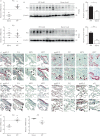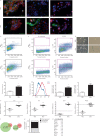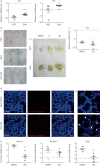Senolytic drugs target alveolar epithelial cell function and attenuate experimental lung fibrosis ex vivo
- PMID: 28775044
- PMCID: PMC5593348
- DOI: 10.1183/13993003.02367-2016
Senolytic drugs target alveolar epithelial cell function and attenuate experimental lung fibrosis ex vivo
Abstract
Idiopathic pulmonary fibrosis (IPF) is a devastating lung disease with poor prognosis and limited therapeutic options. The incidence of IPF increases with age, and ageing-related mechanisms such as cellular senescence have been proposed as pathogenic drivers. The lung alveolar epithelium represents a major site of tissue injury in IPF and senescence of this cell population is probably detrimental to lung repair. However, the potential pathomechanisms of alveolar epithelial cell senescence and the impact of senolytic drugs on senescent lung cells and fibrosis remain unknown. Here we demonstrate that lung epithelial cells exhibit increased P16 and P21 expression as well as senescence-associated β-galactosidase activity in experimental and human lung fibrosis tissue and primary cells.Primary fibrotic mouse alveolar epithelial type (AT)II cells secreted increased amounts of senescence-associated secretory phenotype (SASP) factors in vitro, as analysed using quantitative PCR, mass spectrometry and ELISA. Importantly, pharmacological clearance of senescent cells by induction of apoptosis in fibrotic ATII cells or ex vivo three-dimensional lung tissue cultures reduced SASP factors and extracellular matrix markers, while increasing alveolar epithelial markers.These data indicate that alveolar epithelial cell senescence contributes to lung fibrosis development and that senolytic drugs may be a viable therapeutic option for IPF.
Copyright ©ERS 2017.
Conflict of interest statement
Conflict of interest: Disclosures can be found alongside this article at erj.ersjournals.com
Figures







Comment in
-
Licence to kill senescent cells in idiopathic pulmonary fibrosis?Eur Respir J. 2017 Aug 3;50(2):1701360. doi: 10.1183/13993003.01360-2017. Print 2017 Aug. Eur Respir J. 2017. PMID: 28775054 No abstract available.
References
-
- King TE Jr, Pardo A, Selman M. Idiopathic pulmonary fibrosis. Lancet 2011; 378: 1949–1961. - PubMed
-
- King TE Jr, Bradford WZ, Castro-Bernardini S, et al. . A phase 3 trial of pirfenidone in patients with idiopathic pulmonary fibrosis. N Engl J Med 2014; 370: 2083–2092. - PubMed
-
- Richeldi L, du Bois RM, Raghu G, et al. . Efficacy and safety of nintedanib in idiopathic pulmonary fibrosis. N Engl J Med 2014; 370: 2071–2082. - PubMed
-
- Meiners S, Eickelberg O, Königshoff M. Hallmarks of the ageing lung. Eur Respir J 2015; 45: 807–827. - PubMed
Publication types
MeSH terms
Substances
LinkOut - more resources
Full Text Sources
Other Literature Sources
